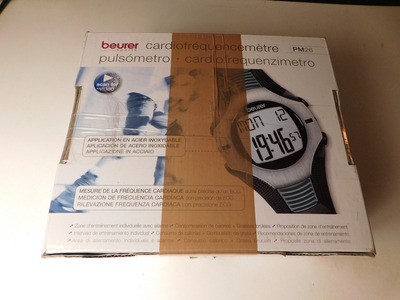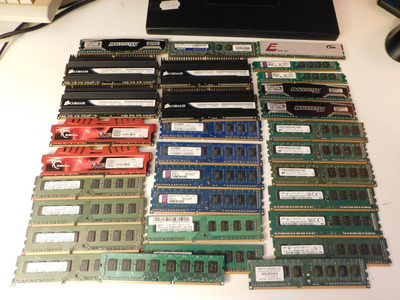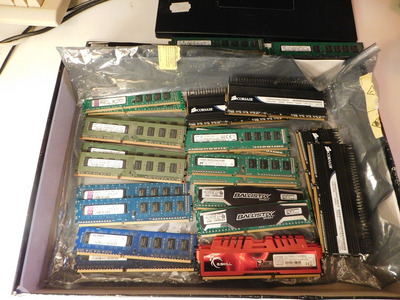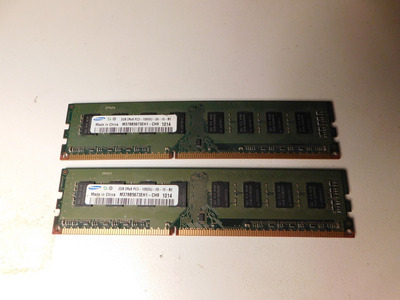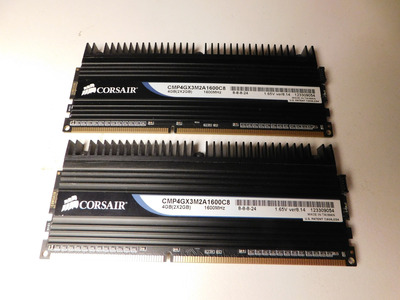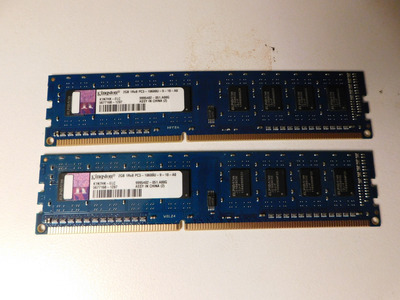The results so far.
i7 4790K @4.9. Asus Z87-A. GTX 780. Windows XP SP3.
Timings are in the CLx/xx-tRCDx/xx-tRPx/xx-tRASxx-tRFCxx/xxx-CRx format.
.
When overclocking I stick to (100:133) 1333, 1600, 1866 , 2133 , 2400 and 2666 MHz settings and 1.5V/1.65V and go for the best performing combination of speed (in MHz) and timings. My overclocked CPUs memory controller seem to have a hard time handling anything above 2400 MHz using the extremely safe voltages I use during this testing. I do set all secondary timings manually, DRAM Refresh Interval is set to its maximum value and I always try to set tRRD to 4 and tFAW to 16 if possible. I slack tRRD in steps of 1 but tFAW in steps of 4 (even if tRRD is stable at 4). I mostly leave the tertiary timings on auto unless I see something odd.
Will this method squeeze the absolute maximum amount of performance out of the memory kits? No of course not but it should be good enough to see how different memory settings, module layouts and memory ICs stack up against each other for actual use.
.
The testing methodology improved and produces scores with less variability. The first memory kits tested needed to be tested again, this is now done. Memory kit #7 that during the first test showed glitched performance using the SPD settings now performed just as expected.
.
SuperPI 32M (Standard deviation <0.5s)
6m 27.516s. OC @2400 10-11-10-22-222-1 tRRD4 tFAW16 @1.65V. 2x8GB dual rank Hynix 12800U 4Gbit MFR 1407. (#25) Page4
6m 28.500s. OC @2400 10-12-11-24-156-1 tRRD4 tFAW16 @1.65V. 2x4GB d.r G.Skill F3-17000CL11D Samsung 2Gbit E-die (#11) Page3
6m 29.672s. OC @2133 9-10-9-24-74-1 tRRD4 tFAW16 @1.65V. 2x2GB dual rank Elpida 10600U 1Gbit BDSE. (#4) Page2
6m 29.891s. OC @2400 11-13-11-25-230-1 tRRD4 tFAW16 @1.65V. 2x8GB dual rank Adata AX3U1600W8G9-DB 4Gbit. (#15) Page4
6m 30.531s. OC @2400 11-13-11-25-224-1 tRRD5 tFAW20 @1.65V. 2x8GB dual rank Samsung 12800U 4Gbit D-die. (#20) Page4
6m 30.531s. OC @2400 11-13-12-24-194-1 tRRD5 tFAW20 @1.65V. 2x8GB dual rank Hynix 12800U 4Gbit AFR. (#19) Page4
6m 30.578s. OC @2400 11-13-11-27-108-2 tRRD5 tFAW20 @1.65V. 2x4GB d.r Corsair Vengeance ver5.11 Hynix 2Gbit BFR. (#23) Page4
6m 30.593s. OC @2400 9-11-11-21-96-1 tRRD4 tFAW20 @1.65V. 2x2GB single rank Samsung 12800E 2Gbit D-die HCK0 (#9) Page2
6m 31.313s. OC @2400 10-11-11-22-96-1 tRRD4 tFAW16 @1.65V. 2x2GB s.r Samsung 10600U unmatched 2Gbit D-die HCH9. (#13) Page3
6m 32.093s. OC @2133 9-12-10-22-98-1 tRRD4 tFAW16 @1.65V. 2x4GB dual rank Corsair XMS3 ver5.11 Hynix 2Gbit BFR 1109. (#21) Page4
6m 33.219s. OC @2133 9-11-10-22-94-2 tRRD4 tFAW16 @1.65V. 2x4GB dual rank Corsair XMS3 ver5.11 Hynix 2Gbit BFR 1202. (#18) Page4
6m 34.500s OC @1866 8-10-9-20-60-1 tRRD4 tFAW16 @1.65V. 2x2GB dual rank Samsung 10600U 1Gbit E-die HCH9. (#6) Page2
6m 34.828s. OC @1866 8-10-9-20-61-1 tRRD4 tFAW16 @1.65V. 2x2GB dual rank Samsung 10600U 1Gbit E-die HCH9.(#1) Page1
6m 35.094s. OC @1866 9-9-9-22-58-1 tRRD4 tFAW16 @1.65V. 2x2GB d.r Corsair Dominator ver3.5 Micron 1Gbit D9KPT/KPV (#8) Page2
6m 35.125s. OC @1866 9-9-9-21-56-1 tRRD4 tFAW16 @1.65V. 2x2GB dual rank Micron 10600U 1Gbit D9KPT. (#16) page4
6m 35.188s. OC @1866 8-10-9-20-60-1 tRRD4 tFAW16 @1.65V. 2x2GB d.r Samsung 10600UE unmatched 1Gbit E-die HCH9. (#12) Page3
6m 35.297s. OC @1866 9-9-9-22-58-1 tRRD4 tFAW16 @1.65V. 2x2GB d.r Corsair Dominator ver3.1 Micron 1Gbit D9KPT/KPV (#17) Page4
6m 35.609s. OC @2133 9-11-10-27-84-1 tRRD4 tFAW16 @1.65V. 2x2GB s.r Crucial Ballistix 12800U Micron 2Gbit D9PFJ (#10) Page2
6m 36.188s. OC @2133 11-11-10-26-124-1 tRRD4 tFAW16 @1.5V. 2x2GB single rank Corsair Dominator ver8.14 Nanya 2Gbit (#2) Page1
6m 36.531s. XMP @2133 11-11-11-28-171-2 @1.6V. 2x4GB dual rank G.Skill F3-17000CL11D-8GBXL Samsung 2Gbit E-die. (#11) page3
6m 38.844s. OC @1866 9-9-8-20-100-1 tRRD4 tFAW16 @1.5V. 2x2GB single rank Kingston 10600U 2Gbit (PSC?). (#5) page2
6m 39.922s. OC @1600 8-8-7-20-84-1 tRRD4 tFAW16 @1.65V. 2x4GB d.r Corsair Vengeance ver2.12 Elpida 2Gbit BCBD/BCSE. (#22) Page4
6m 40.625s. OC @1600 9-8-7-18-88-1 tRRD4 tFAW16 @1.65V. 2x4GB d.r G.Skill 12800CL9D-8GBSR2 Elpida 2Gbit BCBD/BCSE. (#14) Page3
6m 41.578s. OC @1866 10-9-9-23-168-1 tRRD4 tFAW16 @1.65V. 2x4GB single rank Corsair Value Ram 10600U 4Gbit. (#24) Page4
6m 44.422s. OC @1600 10-8-7-22-68-1 tRRD4 tFAW16 @1.65V. 2x2GB single rank Micron 10600U 2Gbit D9LGK. (#7) Page2
6m 44.843s. OC @1600 9-8-8-22-94-1 tRRD4 tFAW16 @1.65V. 2x2GB single rank Kingston 10600U Elpida 2Gbit BCSE. (#3) Page1
6m 45.140s. XMP @1600 8-8-8-24-88-2 @1.65V. 2x2GB dual rank Corsair Dominator ver3.5 Micron 1Gbit D9KPT/KPV. (#8) Page2
6m 45.843s. SPD @1600 9-9-9-28-128-1. 2x4GB dual rank G.Skill Sniper F3-12800CL9D-8GBSR2 Elpida 2Gbit BCBD/BCSE. (#14) page3
6m 46.344s. XMP @1600 9-9-9-24-74-2 @1.65V. 2x2GB dual rank Corsair Dominator ver3.1 Micron 1Gbit D9KPT/KPV (#17) Page4
6m 47.203s. XMP @1600 9-9-9-24-128-2 @1.65V. 2x4GB dual rank Corsair XMS3 ver5.11 Hynix 2Gbit BFR 1202. (#18) Page4
6m 47.297s. XMP @1600 9-9-9-24-128-2 @1.5V. 2x4GB dual rank Corsair Vengeance ver2.12 Elpida 2Gbit BCBD/BCSE. (#22) Page4
6m 47.500s. XMP @1600 9-9-9-24-128-2 @1.5V. 2x4GB dual rank Corsair Vengeance ver5.11 Hynix 2Gbit BFR. (#23) Page4
6m 47.687s. XMP @1600 9-9-9-24-128-2 @1.65V. 2x4GB dual rank Corsair XMS3 ver5.11 Hynix 2Gbit BFR 1109. (#21) Page4
6m 49.750s. SPD @1600 11-11-11-28-128-1. 2x4GB dual rank G.Skill F3-17000CL11D-8GBXL Samsung 2Gbit E-die. (#11) page2
6m 50.656s. SPD @1600 9-9-9-24-128-1. 2x2GB single rank Crucial Ballistix 12800U Micron 2Gbit D9PFJ. (#10) Page2
6m 51.032s. XMP @1600 8-8-8-24-128-2 @1.65V. 2x2GB single rank Corsair Dominator ver8.14 Nanya 2Gbit. (#2) Page1
6m 51.312s. XMP @1600 9-9-9-24-208-2 @1.5V. 2x8GB dual rank Adata AX3U1600W8G9-DB 4Gbit. (#15) Page4
6m 52.016s. SPD @1600 11-11-11-28-208-1. 2x8GB dual rank Samsung 12800U 4Gbit D-die. (#20) Page4
6m 52.078s. SPD @1600 11-11-11-28-208-1. 2x8GB dual rank Hynix 12800U 4Gbit AFR. (#19) Page4
6m 52.313s. SPD @1600 11-11-11-28-208-1. 2x8GB dual rank Hynix 12800U 4Gbit MFR 1407. (#25) Page4
6m 54.156s. SPD @1333 9-9-9-24-74-1. 2x2GB dual rank Samsung 10600U 1Gbit E-die HCH9. (#1) Page1
6m 54.312s. SPD @1333 9-9-9-24-74-1. 2x2GB dual rank Micron 10600U 1Gbit D9KPT. (#16) page4
6m 54.750s. SPD @1333 9-9-9-24-74-1. 2x2GB dual rank Samsung 10600U 1Gbit E-die HCH9. (#6) Page2
6m 54.782s. SPD @1333 9-9-9-24-74-1. 2x2GB dual rank Elpida 10600U 1Gbit BDSE. (#4) Page2
6m 54.782s. SPD @1333 9-9-9-24-74-1. 2x2GB dual rank Corsair Dominator ver3.1 Micron 1Gbit D9KPT/KPV (#17) Page4
6m 54.828s. SPD @1333 9-9-9-24-74-1. 2x2GB dual rank Samsung 10600UE unmatched 1Gbit E-die HCH9. (#12) Page3
6m 55.656s. SPD @1333 9-9-9-24-107-1. 2x4GB dual rank Corsair XMS3 ver5.11 Hynix 2Gbit BFR 1202. (#18) Page4
6m 55.672s. SPD @1333 9-9-9-24-107-1. 2x4GB dual rank Corsair XMS3 ver5.11 Hynix 2Gbit BFR 1109. (#21) Page4
6m 55.672s. SPD @1333 9-9-9-24-74-1. 2x2GB dual rank Corsair Dominator ver3.5 Micron 1Gbit D9KPT/KPV. (#8) Page2
6m 55.844s. SPD @1333 9-9-9-24-107-1. 2x4GB dual rank Corsair Vengeance ver5.11 Hynix 2Gbit BFR. (#23) Page4
6m 55.906s. SPD @1333 9-9-9-24-107-1. 2x4GB dual rank Corsair Vengeance ver2.12 Elpida 2Gbit BCBD/BCSE. (#22) Page4
6m 56.172s. SPD @1600 11-11-11-28-128-1. 2x2GB single rank Samsung 12800E 2Gbit D-die HCK0. (#9) Page2
6m 59.515s. SPD @1333 9-9-9-24-174-1. 2x8GB dual rank Adata AX3U1600W8G9-DB 4Gbit. (#15) Page4
7m 01.328s. SPD @1333 9-9-9-24-107-1. 2x2GB single rank Kingston 10600U 2Gbit (PSC?). (#5) page2
7m 01.875s. SPD @1333 9-9-9-24-107-1. 2x2GB single rank Micron 10600U 2Gbit D9LGK. (#7) Page2
7m 01.891s. SPD @1333 9-9-9-24-107-1. 2x2GB single rank Kingston 10600U Elpida 2Gbit BCSE. (#3) Page1
7m 02.031s. SPD @1333 9-9-9-24-107-1. 2x2GB single rank Corsair Dominator ver8.14 Nanya 2Gbit. (#2) Page1
7m 02.203s. SPD @1333 9-9-9-24-107-1. 2x2GB single rank Samsung 10600U unmatched 2Gbit D-die HCH9. (#13) Page3
7m 03.657s. SPD @1333 9-9-9-24-174-1. 2x4GB single rank Corsair Value Ram 10600U 4Gbit. (#24) Page4
.
Frybench x86 (Render time) (Standard deviation <0.5s)
3m 29s. OC @2400 10-11-10-22-222-1 tRRD4 tFAW16 @1.65V. 2x8GB dual rank Hynix 12800U 4Gbit MFR 1407. (#25) Page4
3m 30s. OC @2400 10-12-11-24-156-1 tRRD4 tFAW16 @1.65V. 2x4GB d.r G.Skill F3-17000CL11D Samsung 2Gbit E-die (#11) Page3
3m 31s. OC @2133 9-10-9-24-74-1 tRRD4 tFAW16 @1.65V. 2x2GB dual rank Elpida 10600U 1Gbit BDSE. (#4) Page2
3m 31s. OC @2400 11-13-11-25-230-1 tRRD4 tFAW16 @1.65V. 2x8GB dual rank Adata AX3U1600W8G9-DB 4Gbit. (#15) Page4
3m 32s OC @2400 11-13-11-25-224-1 tRRD5 tFAW20 @1.65V. 2x8GB dual rank Samsung 12800U 4Gbit D-die. (#20) Page4
3m 32s. OC @2400 11-13-12-24-194-1 tRRD5 tFAW20 @1.65V. 2x8GB dual rank Hynix 12800U 4Gbit AFR. (#19) Page4
3m 32s. OC @2400 9-11-11-21-96-1 tRRD4 tFAW20 @1.65V. 2x2GB single rank Samsung 12800E 2Gbit D-die HCK0 (#9) Page2
3m 32s. OC @2400 10-11-11-22-96-1 tRRD4 tFAW16 @1.65V. 2x2GB s.r Samsung 10600U unmatched 2Gbit D-die HCH9. (#13) Page3
3m 33s. OC @2400 11-13-11-27-108-2 tRRD5 tFAW20 @1.65V. 2x4GB d.r Corsair Vengeance ver5.11 Hynix 2Gbit BFR. (#23) Page4
3m 33s. OC @2133 9-12-10-22-98-1 tRRD4 tFAW16 @1.65V. 2x4GB dual rank Corsair XMS3 ver5.11 Hynix 2Gbit BFR 1109. (#21) Page4
3m 34s. OC @2133 9-11-10-22-94-2 tRRD4 tFAW16 @1.65V. 2x4GB dual rank Corsair XMS3 ver5.11 Hynix 2Gbit BFR 1202. (#18) Page4
3m 34s. OC @1866 8-10-9-20-60-1 tRRD4 tFAW16 @1.65V. 2x2GB dual rank Samsung 10600U 1Gbit E-die HCH9. (#6) Page2
3m 34s. OC @1866 8-10-9-20-61-1 tRRD4 tFAW16 @1.65V. 2x2GB dual rank Samsung 10600U 1Gbit E-die HCH9. (#1) Page1
3m 34s. OC @1866 8-10-9-20-60-1 tRRD4 tFAW16 @1.65V. 2x2GB d.r Samsung 10600UE unmatched 1Gbit E-die HCH9. (#12) Page3
3m 34s. OC @1866 9-9-9-21-56-1 tRRD4 tFAW16 @1.65V. 2x2GB dual rank Micron 10600U 1Gbit D9KPT. (#16) page4
3m 34s. OC @1866 9-9-9-22-58-1 tRRD4 tFAW16 @1.65V. 2x2GB d.r Corsair Dominator ver3.5 Micron 1Gbit D9KPT/KPV (#8) Page2
3m 34s. OC @1866 9-9-9-22-58-1 tRRD4 tFAW16 @1.65V. 2x2GB d.r Corsair Dominator ver3.1 Micron 1Gbit D9KPT/KPV (#17) Page4
3m 36s. OC @2133 9-11-10-27-84-1 tRRD4 tFAW16 @1.65V. 2x2GB s.r Crucial Ballistix 12800U Micron 2Gbit D9PFJ(#10) Page2
3m 37s. OC @2133 11-11-10-26-124-1 tRRD4 tFAW16 @1.5V. 2x2GB single rank Corsair Dominator ver8.14 Nanya 2Gbit (#2) Page1
3m 37s. OC @1866 9-9-8-20-100-1 tRRD4 tFAW16 @1.5V. 2x2GB single rank Kingston 10600U 2Gbit (PSC?). (#5) page2
3m 38s. XMP @2133 11-11-11-28-171-2 @1.6V. 2x4GB dual rank G.Skill F3-17000CL11D-8GBXL Samsung 2Gbit E-die. (#11) page3
3m 39s. OC @1866 10-9-9-23-168-1 tRRD4 tFAW16 @1.65V. 2x4GB single rank Corsair Value Ram 10600U 4Gbit. (#24) Page4
3m 39s. OC @1600 8-8-7-20-84-1 tRRD4 tFAW16 @1.65V. 2x4GB d.r Corsair Vengeance ver2.12 Elpida 2Gbit BCBD/BCSE. (#22) Page4
3m 40s. OC @1600 9-8-8-22-94-1 tRRD4 tFAW16 @1.5V. 2x2GB single rank Kingston 10600U Elpida 2Gbit BCSE. (#3) Page1
3m 40s. XMP @1600 8-8-8-24-88-2 @1.65V. 2x2GB dual rank Corsair Dominator ver3.5 Micron 1Gbit D9KPT/KPV. (#8) Page2
3m 41s. OC @1600 9-8-7-18-88-1 tRRD4 tFAW16 @1.65V. 2x4GB d.r G.Skill 12800CL9D-8GBSR2 Elpida 2Gbit BCBD/BCSE. (#14) Page3
3m 41s. OC @1600 10-8-7-22-68-1 tRRD4 tFAW16 @1.65V. 2x2GB single rank Micron 10600U 2Gbit D9LGK. (#7) Page2
3m 42s. XMP @1600 9-9-9-24-128-2 @1.65V. 2x4GB dual rank Corsair XMS3 ver5.11 Hynix 2Gbit BFR 1202. (#18) Page4
3m 42s. XMP @1600 9-9-9-24-128-2 @1.65V. 2x4GB dual rank Corsair XMS3 ver5.11 Hynix 2Gbit BFR 1109. (#21) Page4
3m 44s. XMP @1600 9-9-9-24-128-2 @1.5V. 2x4GB dual rank Corsair Vengeance ver5.11 Hynix 2Gbit BFR. (#23) Page4
3m 45s. XMP @1600 9-9-9-24-74-2 @1.65V. 2x2GB dual rank Corsair Dominator ver3.1 Micron 1Gbit D9KPT/KPV (#17) Page4
3m 45s. SPD @1600 9-9-9-28-128-1. 2x4GB dual rank G.Skill Sniper F3-12800CL9D-8GBSR2 Elpida 2Gbit BCBD/BCSE. (#14) page3
3m 45s. XMP @1600 9-9-9-24-128-2 @1.5V. 2x4GB dual rank Corsair Vengeance ver2.12 Elpida 2Gbit BCBD/BCSE. (#22) Page4
3m 46s. SPD @1600 11-11-11-28-128-1. 2x4GB dual rank G.Skill F3-17000CL11D-8GBXL Samsung 2Gbit E-die. (#11) page2
3m 47s. SPD @1600 9-9-9-24-128-1. 2x2GB single rank Crucial Ballistix 12800U Micron 2Gbit D9PFJ. (#10) Page2
3m 47s. XMP @1600 8-8-8-24-128-2. @1.65V 2x2GB single rank Corsair Dominator ver8.14 Nanya 2Gbit. (#2) Page 1
3m 47s. XMP @1600 9-9-9-24-208-2 @1.5V. 2x8GB dual rank Adata AX3U1600W8G9-DB 4Gbit. (#15) Page4
3m 47s. SPD @1600 11-11-11-28-208-1. 2x8GB dual rank Samsung 12800U 4Gbit D-die. (#20) Page4
3m 47s. SPD @1600 11-11-11-28-208-1. 2x8GB dual rank Hynix 12800U 4Gbit MFR 1407. (#25) Page4
3m 47s. SPD @1600 11-11-11-28-208-1. 2x8GB dual rank Hynix 12800U 4Gbit AFR. (#19) Page4
3m 52s. SPD @1600 11-11-11-28-128-1. 2x2GB single rank Samsung 12800E 2Gbit D-die HCK0. (#9) Page2
3m 52s. SPD @1333 9-9-9-24-74-1. 2x2GB dual rank Samsung 10600U 1Gbit E-die HCH9. (#6) Page2
3m 52s. SPD @1333 9-9-9-24-74-1. 2x2GB dual rank Samsung 10600U 1Gbit E-die HCH9. (#1) Page1
3m 52s. SPD @1333 9-9-9-24-74-1. 2x2GB dual rank Samsung 10600UE unmatched 1Gbit E-die HCH9. (#12) Page3
3m 52s. SPD @1333 9-9-9-24-74-1. 2x2GB dual rank Elpida 10600U 1Gbit BDSE. (#4) Page2
3m 52s. SPD @1333 9-9-9-24-74-1. 2x2GB dual rank Micron 10600U 1Gbit D9KPT. (#16) page4
3m 52s. SPD @1333 9-9-9-24-74-1. 2x2GB dual rank Corsair Dominator ver3.1 Micron 1Gbit D9KPT/KPV (#17) Page4
3m 52s. SPD @1333 9-9-9-24-107-1. 2x4GB dual rank Corsair Vengeance ver5.11 Hynix 2Gbit BFR. (#23) Page4
3m 52s. SPD @1333 9-9-9-24-107-1. 2x4GB dual rank Corsair Vengeance ver2.12 Elpida 2Gbit BCBD/BCSE. (#22) Page4
3m 53s. SPD @1333 9-9-9-24-74-1. 2x2GB dual rank Corsair Dominator ver3.5 Micron 1Gbit D9KPT/KPV. (#8) Page2
3m 53s. SPD @1333 9-9-9-24-107-1. 2x4GB dual rank Corsair XMS3 ver5.11 Hynix 2Gbit BFR 1109. (#21) Page4
3m 54s. SPD @1333 9-9-9-24-107-1. 2x4GB dual rank Corsair XMS3 ver5.11 Hynix 2Gbit BFR 1202. (#18) Page4
3m 54s. SPD @1333 9-9-9-24-174-1. 2x8GB dual rank Adata AX3U1600W8G9-DB 4Gbit. (#15) Page4
3m 57s. SPD @1333 9-9-9-24-107-1. 2x2GB single rank Kingston 10600U 2Gbit (PSC?). (#5) page2
3m 57s. SPD @1333 9-9-9-24-107-1. 2x2GB single rank Samsung 10600U unmatched 2Gbit D-die HCH9. (#13) Page3
3m 57s. SPD @1333 9-9-9-24-107-1. 2x2GB single rank Corsair Dominator ver8.14 Nanya 2Gbit. (#2) Page1
3m 57s. SPD @1333 9-9-9-24-107-1. 2x2GB single rank Kingston 10600U Elpida 2Gbit BCSE. (#3) Page1
3m 57s. SPD @1333 9-9-9-24-107-1. 2x2GB single rank Micron 10600U 2Gbit D9LGK. (#7) Page2
3m 58s. SPD @1333 9-9-9-24-174-1. 2x4GB single rank Corsair Value Ram 10600U 4Gbit. (#24) Page4
.
Doom III (Standard deviation <1FPS)
673.1 FPS. OC @2400 10-11-10-22-222-1 tRRD4 tFAW16 @1.65V. 2x8GB dual rank Hynix 12800U 4Gbit MFR 1407. (#25) Page4
672.9 FPS. OC @2400 9-11-11-21-96-1 tRRD4 tFAW20 @1.65V. 2x2GB single rank Samsung 12800E 2Gbit D-die HCK0 (#9) Page2
671.9 FPS. OC @2400 10-12-11-24-156-1 tRRD4 tFAW16 @1.65V, 2x4GB d.r G.Skill F3-17000CL11D Samsung 2Gbit E-die (#11) Page3
671.5 FPS. OC @2400 10-11-11-22-96-1 tRRD4 tFAW16 @1.65V. 2x2GB s.r Samsung 10600U unmatched 2Gbit D-die HCH9. (#13) Page3
670.8 FPS. OC @2400 11-13-11-25-224-1 tRRD5 tFAW20 @1.65V. 2x8GB dual rank Samsung 12800U 4Gbit D-die. (#20) Page4
670.4 FPS. OC @2400 11-13-11-25-230-1 tRRD4 tFAW16 @1.65V. 2x8GB dual rank Adata AX3U1600W8G9-DB 4Gbit. (#15) Page4
670.2 FPS. OC @2400 11-13-12-24-194-1 tRRD5 tFAW20 @1.65V. 2x8GB dual rank Hynix 12800U 4Gbit AFR. (#19) Page4
669.4 FPS. OC @2400 11-13-11-27-108-2 tRRD5 tFAW20 @1.65V. 2x4GB d.r Corsair Vengeance ver5.11 Hynix 2Gbit BFR. (#23) Page4
669.2 FPS. OC @2133 9-10-9-24-74-1 tRRD4 tFAW16 @1.65V. 2x2GB dual rank Elpida 10600U 1Gbit BDSE. (#4) Page2
667.5 FPS. OC @2133 9-12-10-22-98-1 tRRD4 tFAW16 @1.65V. 2x4GB dual rank Corsair XMS3 ver5.11 Hynix 2Gbit BFR 1109. (#21) Page4
666.9 FPS. OC @2133 9-11-10-27-84-1 tRRD4 tFAW16 @1.65V. 2x2GB s.r Crucial Ballistix 12800U Micron 2Gbit D9PFJ. (#10) Page2
666.3 FPS. OC @2133 11-11-10-26-124-1 tRRD4 tFAW16 @1.5V. 2x2GB single rank Corsair Dominator ver8.14 Nanya 2Gbit (#2) Page1
665.6 FPS. OC @2133 9-11-10-22-94-2 tRRD4 tFAW16 @1.65V. 2x4GB dual rank Corsair XMS3 ver5.11 Hynix 2Gbit BFR 1202. (#18) Page4
664.2 FPS. OC @1866 8-10-9-20-60-1 tRRD4 tFAW16 @1.65V. 2x2GB dual rank Samsung 10600U 1Gbit E-die HCH9. (#6) Page2
664.0 FPS. OC @1866 8-10-9-20-61-1 tRRD4 tFAW16 @1.65V. 2x2GB dual rank Samsung 10600U 1Gbit E-die HCH9. (#1) Page1
663.8 FPS. OC @1866 9-9-9-21-56-1 tRRD4 tFAW16 @1.65V. 2x2GB dual rank Micron 10600U 1Gbit D9KPT. (#16) page4
663.0 FPS. OC @1866 8-10-9-20-60-1 tRRD4 tFAW16 @1.65V. 2x2GB d.r Samsung 10600UE unmatched 1Gbit E-die HCH9. (#12) Page3
662.6 FPS. OC @1866 9-9-9-22-58-1 tRRD4 tFAW16 @1.65V. 2x2GB d.r Corsair Dominator ver3.1 Micron 1Gbit D9KPT/KPV (#17) Page4
662.6 FPS. OC @1866 9-9-9-22-58-1 tRRD4 tFAW16 @1.65V. 2x2GB d.r Corsair Dominator ver3.5 Micron 1Gbit D9KPT/KPV (#8) Page2
661.5 FPS. OC @1866 9-9-8-21-102-1 tRRD4 tFAW16 @1.5V. 2x2GB single rank Kingston 10600U 2Gbit (PSC?). (#5) page2
661.5 FPS. OC @1866 10-9-9-23-168-1 tRRD4 tFAW16 @1.65V. 2x4GB single rank Corsair Value Ram 10600U 4Gbit. (#24) Page4
661.3 FPS. XMP @2133 11-11-11-28-171-2 @1.6V. 2x4GB dual rank G.Skill F3-17000CL11D-8GBXL Samsung 2Gbit E-die. (#11) page3
658.3 FPS. OC @1600 8-8-7-20-84-1 tRRD4 tFAW16 @1.65V. 2x4GB d.r Corsair Vengeance ver2.12 Elpida 2Gbit BCBD/BCSE. (#22) Page4
656.9 FPS. OC @1600 9-8-7-18-88-1 tRRD4 tFAW16 @1.65V. 2x4GB d.r G.Skill 12800CL9D-8GBSR2 Elpida 2Gbit BCBD/BCSE. (#14) Page3
656.7 FPS. XMP @1600 8-8-8-24-88-2 @1.65V. 2x2GB dual rank Corsair Dominator ver3.5 Micron 1Gbit D9KPT/KPV. (#8) Page2
655.3 FPS. OC @1600 9-9-8-22-94-1 tRRD4 tFAW16 @1.5V. 2x2GB single rank Kingston 10600U Elpida 2Gbit BCSE. (#3) Page1
654.7 FPS. OC @1600 10-8-7-22-68-1 tRRD4 tFAW16 @1.65V. 2x2GB single rank Micron 10600U 2Gbit D9LGK. (#7) Page2
652.7 FPS. XMP @1600 9-9-9-24-74-2 @1.65V. 2x2GB dual rank Corsair Dominator ver3.1 Micron 1Gbit D9KPT/KPV (#17) Page4
652.7 FPS. XMP @1600 9-9-9-24-128-2 @1.65V. 2x4GB dual rank Corsair XMS3 ver5.11 Hynix 2Gbit BFR 1109. (#21) Page4
652.5FPS. XMP @1600 9-9-9-24-128-2 @1.5V. 2x4GB dual rank Corsair Vengeance ver5.11 Hynix 2Gbit BFR. (#23) Page4
651.9 FPS. XMP @1600 8-8-8-24-128-2 @1.65V. 2x2GB single rank Corsair Dominator ver8.14 Nanya 2Gbit. (#2) Page1
651.5 FPS. SPD @1600 9-9-9-28-128-1. 2x4GB dual rank G.Skill Sniper F3-12800CL9D-8GBSR2 Elpida 2Gbit BCBD/BCSE. (#14) page3
651.3 FPS. XMP @1600 9-9-9-24-128-2 @1.5V. 2x4GB dual rank Corsair Vengeance ver2.12 Elpida 2Gbit BCBD/BCSE. (#22) Page4
651.1 FPS. XMP @1600 9-9-9-24-128-2 @1.65V. 2x4GB dual rank Corsair XMS3 ver5.11 Hynix 2Gbit BFR 1202. (#18) Page4
650.7 FPS. SPD @1600 9-9-9-24-128-1. 2x2GB single rank Crucial Ballistix 12800U Micron 2Gbit D9PFJ. (#10) Page2
649.7 FPS. XMP @1600 9-9-9-24-208-2 @1.5V. 2x8GB dual rank Adata AX3U1600W8G9-DB 4Gbit. (#15) Page4
647.6 FPS. SPD @1600 11-11-11-28-128-1. 2x4GB dual rank G.Skill F3-17000CL11D-8GBXL Samsung 2Gbit E-die. (#11) page2
645.2 FPS. SPD @1600 11-11-11-28-208-1. 2x8GB dual rank Samsung 12800U 4Gbit D-die. (#20) Page4
645.2 FPS. SPD @1600 11-11-11-28-208-1. 2x8GB dual rank Hynix 12800U 4Gbit MFR 1407. (#25) Page4
644.5 FPS. SPD @1600 11-11-11-28-208-1. 2x8GB dual rank Hynix 12800U 4Gbit AFR. (#19) Page4
644.5 FPS. SPD @1600 11-11-11-28-128-1. 2x2GB single rank Samsung 12800E 2Gbit D-die HCK0. (#9) Page2
642.9 FPS. SPD @1333 9-9-9-24-107-1. 2x4GB dual rank Corsair Vengeance ver2.12 Elpida 2Gbit BCBD/BCSE. (#22) Page4
642.3 FPS. SPD @1333 9-9-9-24-74-1. 2x2GB dual rank Samsung 10600U 1Gbit E-die HCH9. (#6) Page2
642.3 FPS. SPD @1333 9-9-9-24-74-1. 2x2GB dual rank Corsair Dominator ver3.1 Micron 1Gbit D9KPT/KPV (#17) Page4
642.2 FPS. SPD @1333 9-9-9-24-74-1. 2x2GB dual rank Elpida 10600U 1Gbit BDSE. (#4) Page2
642.0 FPS. SPD @1333 9-9-9-24-74-1. 2x2GB dual rank Samsung 10600U 1Gbit E-die HCH9. (#1) Page1
641.8 FPS. SPD @1333 9-9-9-24-107-1. 2x4GB dual rank Corsair Vengeance ver5.11 Hynix 2Gbit BFR. (#23) Page4
641.6 FPS. SPD @1333 9-9-9-24-74-1. 2x2GB dual rank Samsung 10600UE unmatched 1Gbit E-die HCH9. (#12) Page3
641.2 FPS. SPD @1333 9-9-9-24-107-1. 2x4GB dual rank Corsair XMS3 ver5.11 Hynix 2Gbit BFR 1109. (#21) Page4
640.6 FPS. SPD @1333 9-9-9-24-74-1. 2x2GB dual rank Micron 10600U 1Gbit D9KPT. (#16) page4
640.4 FPS. SPD @1333 9-9-9-24-74-1. 2x2GB dual rank Corsair Dominator ver3.5 Micron 1Gbit D9KPT/KPV. (#8) Page2
639.9 FPS. SPD @1333 9-9-9-24-107-1. 2x4GB dual rank Corsair XMS3 ver5.11 Hynix 2Gbit BFR 1202. (#18) Page4
639.5 FPS. SPD @1333 9-9-9-24-107-1. 2x2GB single rank Samsung 10600U unmatched 2Gbit D-die HCH9. (#13) Page3
638.5 FPS. SPD @1333 9-9-9-24-107-1. 2x2GB single rank Micron 10600U 2Gbit D9LGK.
638.5 FPS. SPD @1333 9-9-9-24-174-1. 2x8GB dual rank Adata AX3U1600W8G9-DB 4Gbit. (#15) Page4
638.3 FPS. SPD @1333 9-9-9-24-107-1. 2x2GB single rank Corsair Dominator ver8.14 Nanya 2Gbit. (#2) Page1
638.0 FPS. SPD @1333 9-9-9-24-107-1. 2x2GB single rank Kingston 10600U 2Gbit (PSC?). (#5) page2
636.8 FPS. SPD @1333 9-9-9-24-107-1. 2x2GB single rank Kingston 10600U Elpida 2Gbit BCSE. (#3) Page1
635.7 FPS. SPD @1333 9-9-9-24-174-1. 2x4GB single rank Corsair Value Ram 10600U 4Gbit. (#24) Page4
New PC: i9 12900K @5GHz all cores @1.2v. MSI PRO Z690-A. 32GB DDR4 3600 CL14. 3070Ti.
Old PC: Dual Xeon X5690@4.6GHz, EVGA SR-2, 48GB DDR3R@2000MHz, Intel X25-M. GTX 980ti.
Older PC: K6-3+ 400@600MHz, PC-Chips M577, 256MB SDRAM, AWE64, Voodoo Banshee.
